
 |
|
|
#31 |
|
Keris forum moderator
Join Date: Aug 2006
Location: Nova Scotia
Posts: 7,244
|
Hi Fearn. Your point is well taking on the use of the ice pick grip with the Piper knife system. It looks fast, fierce and dangerous from the videos. Of course this grip is used with a rather small knife and in conjunction with a specific martial art which maintains a protection of the torso throughout. In fact the knife seems to rarely move above the torso in these moves, quite unlike Norman Bates use of the butcher knife in Psycho. Also the elbows and your other hand are almost as likely to deal the finishing blows as the knife. Very scary looking art.
I tried some of these moves (at a much slower speed i must say  ) with the reverse grip and must say that i can see doing some effective fighting this way. The hilt does still feel a bit awkward in the hand though. Then i turned the blade back and adopted the more accepted grip which actually allows a grip on the blade as well as the handle with the thumb and fore finger gripping the base of the blade. From my perspective the blade control and speed is greatly enhanced in this position. So is striking distance. If i were going to fix the hilt in just one position this would be the one i would chose. Others might have a different experience. Your mileage may vary. ) with the reverse grip and must say that i can see doing some effective fighting this way. The hilt does still feel a bit awkward in the hand though. Then i turned the blade back and adopted the more accepted grip which actually allows a grip on the blade as well as the handle with the thumb and fore finger gripping the base of the blade. From my perspective the blade control and speed is greatly enhanced in this position. So is striking distance. If i were going to fix the hilt in just one position this would be the one i would chose. Others might have a different experience. Your mileage may vary.  
|
|
|

|
|
|
#32 | |
|
Member
Join Date: Apr 2008
Posts: 235
|
Quote:
 I am not a native English speaker and sometimes getting the right tone is difficult, especially with such a difficult form of humor as sarcasm. Yes, I am fully aware that Mr. Bates didnt use a keris on the Hitchcock movie but that wasnt the point. The point (pun intended) was that it could of have been a small keris but nuff about that  It seems that this subject is clear now. That is good. Now we know. Cheers, J |
|
|
|

|
|
|
#33 |
|
Member
Join Date: May 2006
Posts: 7,070
|
This discussion has begun to turn in a direction that has been previously travelled.
The destination of those previous journeys along this road was not a pleasant one, so I do hope that during this current journey we can all admit the very obvious truth that all men do not walk in the same way, take paces of the same length nor cover ground at the same speed. I would hope that some of what I may write will encourage others to pursue the sources of knowledge of the keris. Raffles was in Jawa after 1812 and his History of Java was finished before 1818. In "History" he wrote that the keris in Jawa at that time had assumed the position of the small sword in Europe of fifty years previous. In other words, it was a required part of the dress of a gentleman, and was occasionally used as a weapon. From other historical writings, for example Thorn "The Conquest of Java", the works of Ricklefs, especially "War, Culture and Economy in Java, 1677-1726", and the Pigeaud's "Java in the Fourteenth Century" we can see that the keris was most definitely a weapon, and not only a weapon for personal use, but a weapon used in the battle field context, and in the context of a hunting arm. In 19th century Central Jawa, condemned criminals were armed with a keris and matched with tigers . In 14th century Majapahit, exhibitions of keris play were staged for entertainment. Again during the Majapahit period, civilians carried the keris and used it at the slightest provocation (Groeneveldt, "Historical notes on Indonesia & Malaya from Chinese Sources). I once knew a retired British serviceman who had been stabbed in the thigh with a keris by a combatant in Malaya during the 1950's. The temple carvings of Prambanan http://www.kerisattosanaji.com/Prambanan.html and Panataran http://www.kerisattosanaji.com/PANATARAN.html are accepted by authorities in this field of study to represent the style and conditions existing in Jawa at the time they were carved. The stories are Indian, but the carvings on the Javanese candis show Javanese representations. The keris-like daggers shown in these carvings were one of the contributing factors to the origin of the modern keris. They were not keris as we now know the keris, but they shared many similarities with the modern keris. My "Origin" article http://www.vikingsword.com/ethsword/maisey/index.html presents more on this subject. From a simplistic point of view, the keris developed from an overarm stabbing weapon to a weapon used with a rapier grip. This is true, and can be demonstrated by the evidence. However, like the keris itself, its usage has many facets, and those facets do not allow for a line of reasoning in respect of method of usage that restricts the keris to a single grip. George Cameron Stone, "Glossary" (1934) :- "Prince Pakoet Alam at Djockjakarta showed me the old methods of fencing with a kris. He said that if a man had only one kris with him he held the scabbard in his left hand with the straight part extending along his forearm and guarded with it. If he had two krisses, he took his favourite in his right hand, and the other in his left to guard with. The left-hand kris was held against his forearm with the edge and the point at the top outward. In this position it was not only useful as a guard , but if his opponent tried to catch his arm a slight motion would cut his hand severely." We are now in the 21st century. We are long way from the time when the keris was used as a daily tool to defend and to attack. Many of us are a long way from the cultural thought patterns that guided the users of keris in those far distant times. What we see as a keris, and the ways in which it was used is a construct that is very often based upon our experience in our own world, that is the world of the 21st century:- a world where previous development has produced order and formality. We see the end product of more than 1000 years of development, both of the keris, and of the ways in which it might have been used. To understand the keris we need to try to understand it in the cultural and historical context in which it was used. Don Draeger was not an authority on the keris, but he was a respected authority on Asian combat and weapons systems. He is reported as saying something to the effect of:- " At this remove from the time when the keris was used as a weapon, who can state with any authority exactly how it was used in the past?" Of course, nobody can. We have a few isolated representations of various grips, we have a few isolated historical reports, but we do not have any detailed writings of old time keris usage. We can construct a general theory on keris usage, we can use logic to provide probabilities, but we cannot state with any certainty that any particular method of use of the keris is "correct". Consider this:- if the modern keris was invariably used in a rapier grip, why is the base assymetric? Material was scarce, the keris was not an implement for structured fencing, so the assymetry provided only very rare function as a protective device. A much shorter extention of the gonjo would have served perfectly well as a support for the base of the index finger when the keris was used in a rapier thrust. Form does follow function as David has pointed out. Try holding a keris, especially one with an upright hilt, in the reverse position, with the ham of the hand supported by the gonjo. Now look at the temple carvings. I would suggest that a master of the keris, from the distant past, would not have limited himself to any single grip of his weapon, but would have possessed the virtuosity to adapt the grip to the circumstances. Last edited by A. G. Maisey; 23rd November 2008 at 04:24 AM. |
|
|

|
|
|
#34 |
|
Member
Join Date: Dec 2004
Location: Singapore
Posts: 1,180
|
Hi Jussi,
The relief carving showed an ancient blade which may or may not be the predecessor of the keris. Also, we do not know how the ancients used the earliest kerises, but staying in the here and now, we do see silat groups (i.e. Malay/Indon martial arts schools) which demonstrate the use of kerises as we know today. I'm in Singapore, somewhere in the heart of Southeast Asia, home to the keris, and I'm fortunate to see some of such silat demonstrations in person. Some of my Malay friends are actual silat practioners or are good enough to be in a position to instruct in silat. I tried searching for a youtube video on how the Malay/Bugis keris is used, and I think the following is a good example to show how kerises are used now, and by extension, the likely position the hilt would have assumed for the purpose of fighting.  http://www.youtube.com/watch?v=sDFgG_LhKlg |
|
|

|
|
|
#35 |
|
Member
Join Date: May 2006
Posts: 7,070
|
Kai Wee I agree that the relief carving from Candi Panataran, that Jussi has chosen to illustrate his point, is perhaps not the best for this purpose.
In spite of the fact that reproductions of this relief have been published many times in Indonesia to illustrate the historicity of the keris, in fact, it lacks some of the features that we would normally like to associate with the keris, including the archaic proto types of the keris. This deficiency has never seemed to worry those Indonesian publishers though:- they simply altered the published images so that the missing gandik was magically included, and the blade became assymetric. There are other representations of proto keris at Panataran, but I believe it is perhaps better to use one of the representations from Prambanan. This representation inarguably has the assymetric blade and gandik of the modern keris, and it dates from an earlier time than Panataran. I have studied these carvings at first hand, under magnification, and over a period of years. I have obtained verification from Indonesian archeological officials as to the original state of the Prambanan carving shown here, and I have confirmed this verification by my own examination under magnification. The image shown here from Prambanan is original, undamaged, and unaltered, and it shows a keris-like dagger which possesses many of the features of the modern keris. It also shows the way in which these daggers were used. Jussi, correct me if I'm wrong, but the way I read your posts is that you are saying pretty much the same thing that I'm saying, that is:- we do not know exactly how the keris was used in the past, however, there is more than one possible way in which it could have been used. Last edited by A. G. Maisey; 23rd November 2008 at 11:36 AM. |
|
|

|
|
|
#36 |
|
Keris forum moderator
Join Date: Aug 2006
Location: Nova Scotia
Posts: 7,244
|
For me it is not a question as to whether the keris or even the proto-keris were or could be used in an overhand stabbing action. What we are talking about is the keris at hand in this thread. All of the proto-keris in these reliefs have an upright handle as far as i know. The angled handle presented in this thread and common to the other bugis keris that we are discussing with "reversed" hilts presents a completely different challenge if we consider using the "ice pick" grip for an overhand stab. I think that both Alan and Jussi are absolutely correct. We will never know exactly how the keris and proto-keris were used in the past and certainly more than one grip is a possibility. But i think the question in this thread must remain specific to this type of angled hilt, not the upright hilts of the proto-keris or other upright hilts common to other keris. What i am suggesting is that everyone who has such a keris at hand try these various grips with the hilt in these different positions.. How does it feel? Which grip feels "right" to you? For me the "ice pick" grip with the "reversed" hilt is just a bit awkward, though it is usable. It feels uncomfortable in the hand though. Does this mean that it wasn't ever used? Not at all. We can only ask ourselves what is most likely based on practicality and what we know of these keris and the fighting styles that exist today.
Alan, you wrote: "I would suggest that a master of the keris, from the distant past, would not have limited himself to any single grip of his weapon, but would have possessed the virtuosity to adapt the grip to the circumstances." This may well be so, but if one is to fix a hilt in one position for battle, which would it be? This is not so much a problem with an upright hilt style, but with these angled hilts it is a different story. While i do find that the "ice pick" grip is workable with the hilt in a reverse position, it seems near impossible with the hilt in what has been assumed to be the "normal" position. Try it and see for yourself. The master might have the virtuosity to adapt the grip to different circumstances, but he would not be able to change the positions of a fixed hilt in the heat of battle if those circumstances changed. 
|
|
|

|
|
|
#37 |
|
Member
Join Date: Dec 2004
Posts: 1,247
|
Hi Jussi,
Thanks for checking with this keris. We all seem to agree that it should be held in a forward (rapier, sword) grip. Thanks for checking. Just to make sure I'm not getting too confused, did you check a keris with a reversed hilt, or a normal hilt? Hi Alan, I'm not disagreeing with the notion the keris in general are designed to be held point forward. I've read Draeger and Stone as well, and to me, this was obvious. My concern in this case is that we have a keris with the hilt mounted "wrong," and one hypothesis to check is that some creative Bugi mounted the hilt differently that way so that it could be held in a different (icepick) grip. This can be tested simply by holding a keris with a reversed hilt. If it's still more awkward in reverse, then the hypothesis is disproved. Best, F |
|
|

|
|
|
#38 |
|
Member
Join Date: May 2006
Posts: 7,070
|
I'm sorry gentlemen, I moved away from consideration of the keris that began this thread long ago.
To me, the question in respect of this specific keris of Freddy's cannot be settled:- we know too little about it; anything is possible. I'm just not prepared to hypothesise in respect of something that we don't have enough evidence for.I believe I corrected my initial spontaneity in post #20. What we do know is that keris of this type did on occasion have their hilts mounted in this reverse position. Did this specific keris of Freddy's have its hilt mounted in reverse position by a past owner indigenous to place of origin of this keris? I most sincerely doubt if any amongst us can answer that question. My most recent posts have most definitely been in respect of the keris in general. In so far as adapability of the Bugis style hilt to both rapier style and icepick style grip. With the hilt in a position where it extends above the gandik, an ice-pick grip is not only possible, but is distinctly comfortable and feels "right", to use this grip with the hilt in this position, the blade is reversed so that the side of the hand rests on the long part of the gonjo. With a hilt in the reverse position, again, both method of grip is possible. Personally, I don't think that it would have mattered a great deal how the hilt was fixed:- each person would have fixed it as suited himself, and used it according to his own style. Possibly an ordinary farmer or seaman could have gone through his life without ever drawing blood with his keris, and he probably had only a vague idea of how to use it, on the other hand the professional enforcer, or pirate, or standover man, or bandit, or other frequent user of violence would have had a bag of tricks that allowed him to use any one of a number of grips, as the circumstances demanded. Many years ago I had the good fortune to be taught just a little of the way in which a professional assassin thinks and works. The principal philosophy of my teacher was that one never exposes onself to risk. One waits until the opportunity presents itself and then does the job. This man was Chinese-Javanese and he was not a user of a keris, but a user of knife. Bearing in mind the principles of Malay and Javanese warfare and personal combat, I doubt that the philosophy of experienced users of the keris in times past would have varied much from those of my teacher. If this is so, it is only reasonable that the professional would not limit his ability to earn his pay by limiting himself to a single method of use of his tools of trade. It seems that once again I have wandered away from discussion of Freddy's keris. Whatever anybody wishes to propose in respect of that particular keris, I agree with. However, in respect of the keris in general and its methods of use in historical times, I suggest that although we cannot know anything about these with any certainty, a prudent user would have had flexibility of style.I think that the only thing I cannot agree with is that there might have been a rigid "one style suits all" approach, universally adopted by all users. |
|
|

|
|
|
#39 |
|
Member
Join Date: Apr 2008
Posts: 235
|
Greetings,
I know nothing about these things but did found this on the internet.  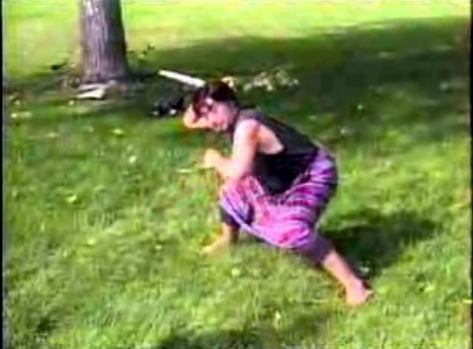 Short video: One Dutch-Indoīs training footage from the 1970īs Thanks, J |
|
|

|
|
|
#40 | |
|
Member
Join Date: Apr 2008
Posts: 235
|
Quote:
Thanks, J |
|
|
|

|
|
|
#41 |
|
Keris forum moderator
Join Date: Aug 2006
Location: Nova Scotia
Posts: 7,244
|
Well Jussi, Victor and his family have quite the reputation in silat circles AFAIK
 , so it is obvious that at least some silat teacher is using this "reverse" hilt position and alternative grips in their art. His grip(s) do(es) look a little different from the "ice pick" grip we have been discussing though. That grip i still don't find comfortable in either position, but Alan does so i guess it is fairly subjective. To each their own. Live and let live. , so it is obvious that at least some silat teacher is using this "reverse" hilt position and alternative grips in their art. His grip(s) do(es) look a little different from the "ice pick" grip we have been discussing though. That grip i still don't find comfortable in either position, but Alan does so i guess it is fairly subjective. To each their own. Live and let live.  
|
|
|

|
|
|
#42 |
|
Member
Join Date: May 2006
Posts: 7,070
|
Standard orientation, and reverse orientation using the broken grip keris previously shown.
Forward grip and reverse grip. Different parts of the hand act as the grip cushion, all grips shown feel natural and comfortable. Other variations of grip are possible and could work as well as the ones I picture here. |
|
|

|
|
|
#43 |
|
Member
Join Date: Aug 2005
Location: Australia
Posts: 372
|
Unusual position, that last illustration of yours Alan. Ergonomically we dont vertically load the wrist much in that position. Interestingly there has been some work on using a hiking pole in almost exactly this position with a grip not unlike the keris grip. The research suggested that it was a good position to take load in, so it is very likely you could use a keris quite efficiently with this grip.
http://www.pacerpole.com/index.html drd |
|
|

|
|
|
#44 |
|
Member
Join Date: May 2006
Posts: 7,070
|
The keris in the hand using that last position is very, very natural and comfortable. The ham of the hand is fully supported by the top of the gonjo, and it feels as I could give a blow a lot of force. In fact, this is exactly an ice-pick grip, except that the hilt does not go up through the centre of the hand.
Now, if we look at the reliefs of proto-keris at Prambanan, we see pretty much the same grip; yes, the hilts on those weapons are vertical, but the force of the blow is taken into the ham of the hand where it is supported on the gonjo. You can deliver a blow with a lot of force using such a grip. |
|
|

|
|
|
#45 |
|
Member
Join Date: Jun 2007
Posts: 401
|
IMHO, keris grip should be held in the most natural way, whereby the blade should be parallel to the ground and the hilt is angled about 45 degree from the gandik. You dont have to use a lot of force to penetrate your opponents abdomen or neck, but rather the palm will do the job with very less effort. Other ways could be deemed taboo in the regarded palace silat, but of course kampung folks would have other ideas. Though probably as effective, it is still considered wrong in palace ethics. I am speaking from the Malay palace point of views BTW

|
|
|

|
|
|
#46 |
|
Member
Join Date: Apr 2008
Posts: 235
|
Dont you dare to stab me on a wrong way!
  . . . . . . . . . . . . . . . . . . . . . . . . . . . . . . . . . . . IMO this guy got it right - itīs not the style that counts, its the end result!   Thanks, J Last edited by Jussi M.; 24th November 2008 at 12:16 PM. |
|
|

|
|
|
#47 |
|
Member
Join Date: Dec 2004
Location: Sint-Amandsberg (near Ghent, Belgium)
Posts: 830
|
Most interesting post, guys.
I've been reading and looking at the added links. As promised, I post pictures of this keris (or Tappi as Sipakatuo pointed out) when in my hand. At first, I want to state that it's a small keris with a small handle and I have big European hands  Here is first, in my humble opinion, the best way to hold this keris. The handle, when sheathed, would point a bit to the front, away from the wearer's body. 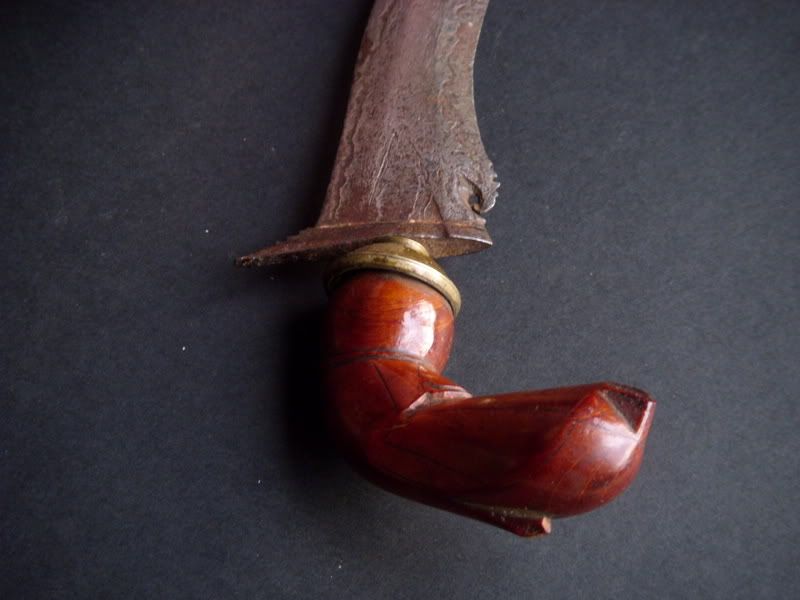  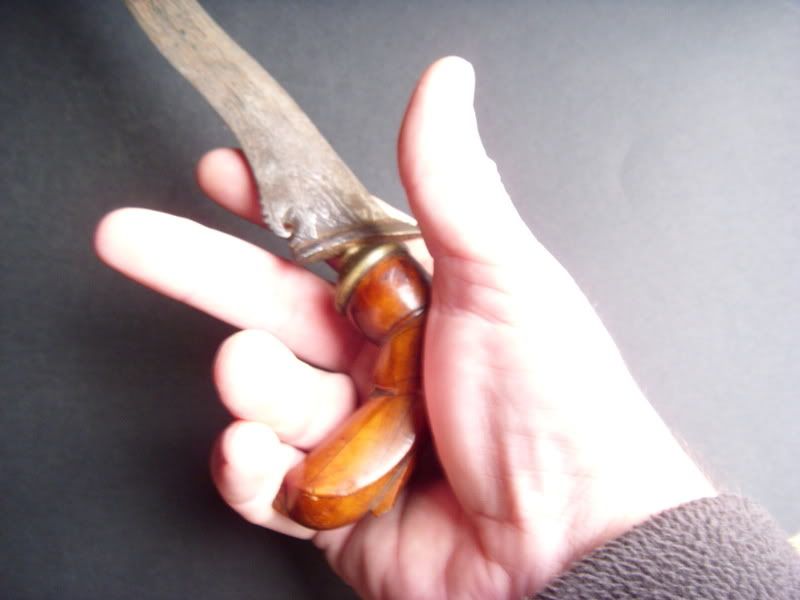 Secondly, I put the handle in the position it was when I got this piece. I must say that, after straightening the peksi (or watting), it was easier to get a grip. Before there just wasn't enough room for my fingers. Therefore, I believe the peksi was bent by accident in the past. I must say in this way you also get a good grip of the keris. This grip and the first one make it possible to deliver straightforward thrusts and also cuts. 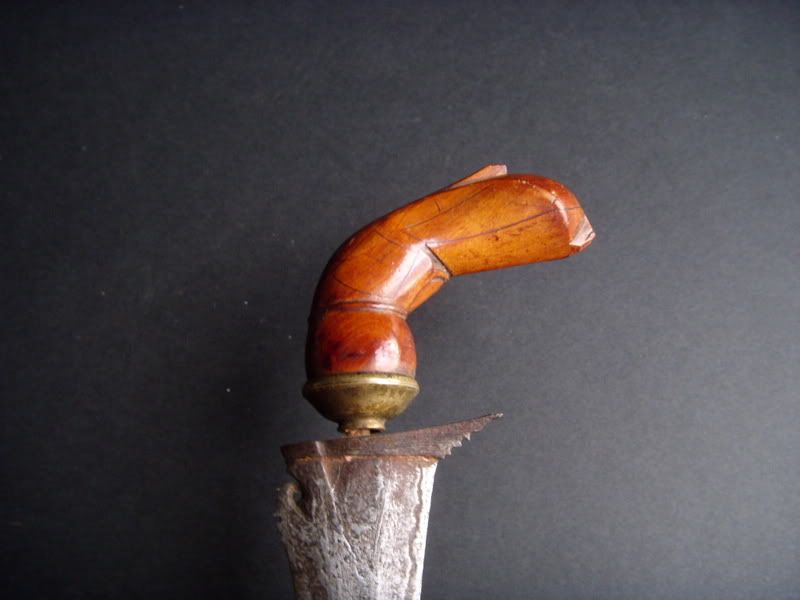 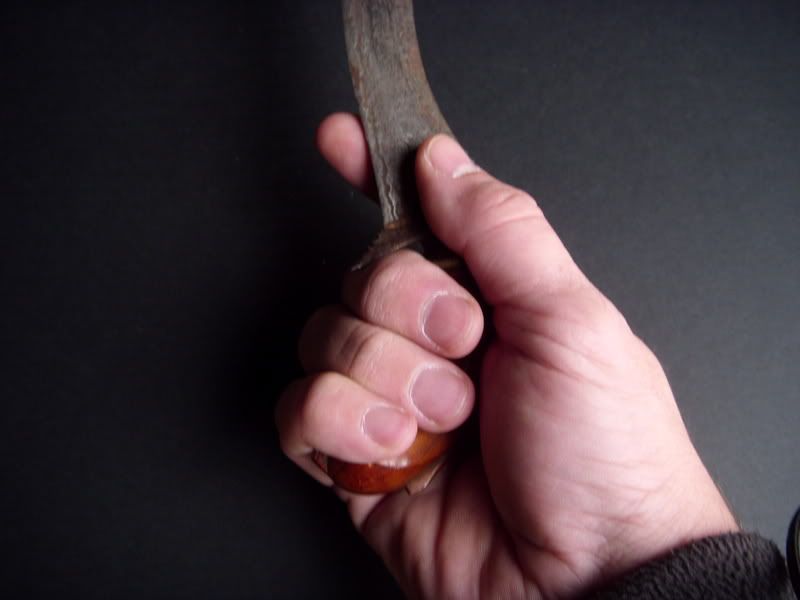 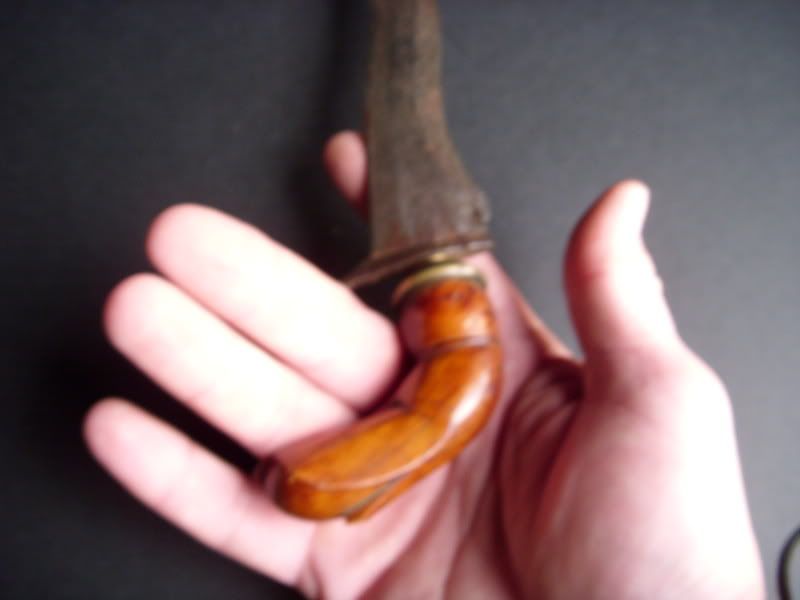
|
|
|

|
|
|
#48 |
|
Member
Join Date: Dec 2004
Location: Sint-Amandsberg (near Ghent, Belgium)
Posts: 830
|
I also tried the 'ice pick' hold. The grip is in the second position. I had to grip the handle in such a way that my little finger was on the blade. My ring finger was supported by the ganja. It was a firm grip, but I wonder if my hand wouldn't be cut if I delivered a downward thrust.
 Could of course be due to my big hands  Anyway, here are the last pics : 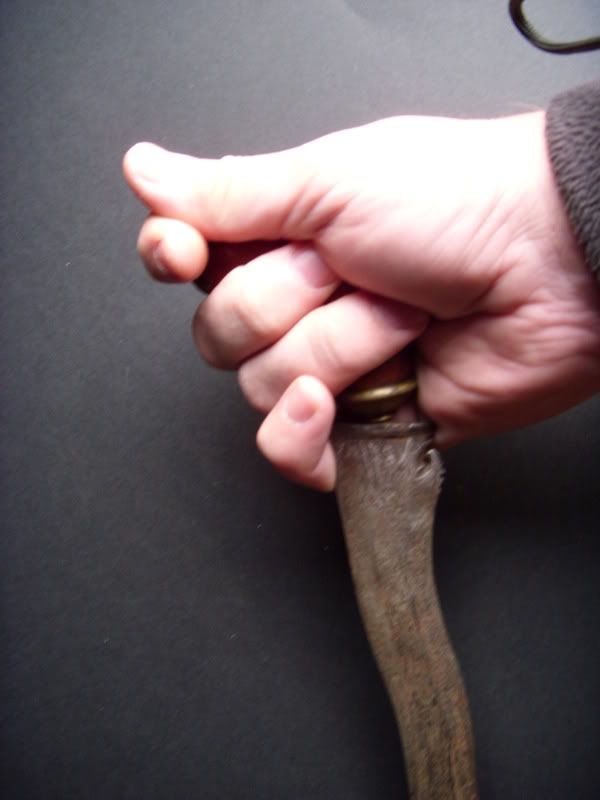 
|
|
|

|
|
|
#49 |
|
Keris forum moderator
Join Date: Aug 2006
Location: Nova Scotia
Posts: 7,244
|
OK Jussi, you are just cracking me up now.
 Alan and Freddy, thanks for the photo illustrations. They are most helpful in this discussion. Yes Alan, that is exactly how i held my keris in the "ice pick" grip. It still wasn't comfortable for me, but that shouldn't stop anyone else if it suits them.  It does seem perhaps more indisputable (words chosen to avoid the absolute It does seem perhaps more indisputable (words chosen to avoid the absolute  ) that this grip does limit the reach of the blade in action though. ) that this grip does limit the reach of the blade in action though. Freddy makes a good point about the size of Western hands in this experiment. And your hilt does seem a bit smaller than the ones Alan and i are working with. I can't speak to the concept of palace taboos since i don't know enough about this. It does seem to me though that went people get into a fight, especially when their life depends upon the outcome, they tend to fall back on what ever method works best for them. |
|
|

|
|
|
#51 |
|
Member
Join Date: Apr 2008
Posts: 235
|
Would you like to see my hilt? - it is reversed
  Thanks, J |
|
|

|
|
|
#52 |
|
Member
Join Date: Dec 2004
Location: Sint-Amandsberg (near Ghent, Belgium)
Posts: 830
|
Alam Shah, you get it exactly right : the length is 22,5 cm (or 9 inches).
Fred |
|
|

|
|
|
#53 |
|
Member
Join Date: May 2006
Posts: 7,070
|
Yes David, there are no absolutes.
I posted my pics of grip positions only to show that the possibilities are there. In real life situations many things can and do happen that fall outside the parameters of prescribed usage or behaviour, and this ,I am sure, is true of keris usage, as it is of many other things. We can talk about kraton standards, and silat practices, and so on, and so on, but in days past, and faced with the many possibilities that could arise, I have no doubt at all that the men who used the keris as a weapon developed their own methodologies. There are many other possibilities of grip that I did not show, but which can be perfect for specific situations. David, you're perfectly correct in that an ice pick grip does reduce reach, however, to the extent that it reduces reach, it increases power. In a melee situation, as in a press of bodies in combat, the ice pick grip is the preferred grip, however, in a one on one situation, especially where combatants might not be of equal physical stature or prowess, the rapier grip can compensate for those physical shortcomings. These days I think that perhaps we may tend to see the keris as a rather refined implement:- the "prayer in steel", and so forth, however, if we read our history, it does not take very long to realise that in the distant past it had an entirely different character, and this character was not quite so sanitised as it today. |
|
|

|
|
|
#54 |
|
Member
Join Date: Jun 2007
Posts: 401
|
Kraton or palace is the place where this art is kept alive - in fact most of the totokromo / local customs are still being determined by the palace.
Keris came from the kraton / palace, it's where the most classic silat style still being practised (sometimes secretly to this day). No doubt that commoners would use the keris they deemed fit, but it's still against the normal tatakrama or adab of the palace's standard. So, if iwere asked which way is the most correct way to grip a keris handle, I would opt for the palace's way. Make no mistake, all the grips shown here are correct, as long as they can do the job. I am only pointing out the most correct way. |
|
|

|
|
|
#55 | |
|
Member
Join Date: Jan 2005
Location: Singapore
Posts: 1,248
|
Quote:

|
|
|
|

|
|
|
#56 |
|
Member
Join Date: Jun 2007
Posts: 401
|
Agreed to certain extent.... but the palace is the source that I feel is the closest ways how the keris was wielded in the olden days. Evolved, but still maintained its originality......
|
|
|

|
|
|
#57 |
|
Member
Join Date: May 2006
Posts: 7,070
|
Penangsang, you are unquestionably correct, from a 20th.-21st. century perspective.
However, what we see and understand from our present perspective is not necessarily applicable to times past. Equally, when we consider kraton practices and standards as they apply today, those practices and standards do not necessarily reflect the situation from , say, 500 years ago. In order to understand the keris we need to broaden our studies to include history, literature, sociological and anthropological fields---at least. I agree with you completely that at our present point in time, the various kratons are arbiters of "correctness" in many fields, however, that "correctness" can only ever extend as far as the influence of any particular kraton. Move into a different area of influence, and the standards of "correctness" can, and do, change. How much more can those standards change when we move backwards through the dimension of time, and also through the dimension of space? To understand the past , we need to try to adopt a mode of thought that is in harmony with the past---and that is not always the easiest thing to do. |
|
|

|
|
|
#58 | |
|
Member
Join Date: Oct 2008
Location: Amsterdam, Netherlands
Posts: 159
|
Quote:

|
|
|
|

|
|
|
#59 |
|
Member
Join Date: Nov 2013
Posts: 456
|
Apologies for resurrecting such an old thread, but the keris I bought recently, show in this thread...
http://www.vikingsword.com/vb/showthread.php?t=19929 ...also has what would be considered a "reversed" grip, and the blade is firmly attached to the hilt. I tried to pull it out or twist it as hard as I could and it wouldn't budge. It might have been affixed with damar, or maybe some western owner glued it into place. I'll try heating it up and see if it budges. |
|
|

|
 |
| Thread Tools | Search this Thread |
| Display Modes | |
|
|